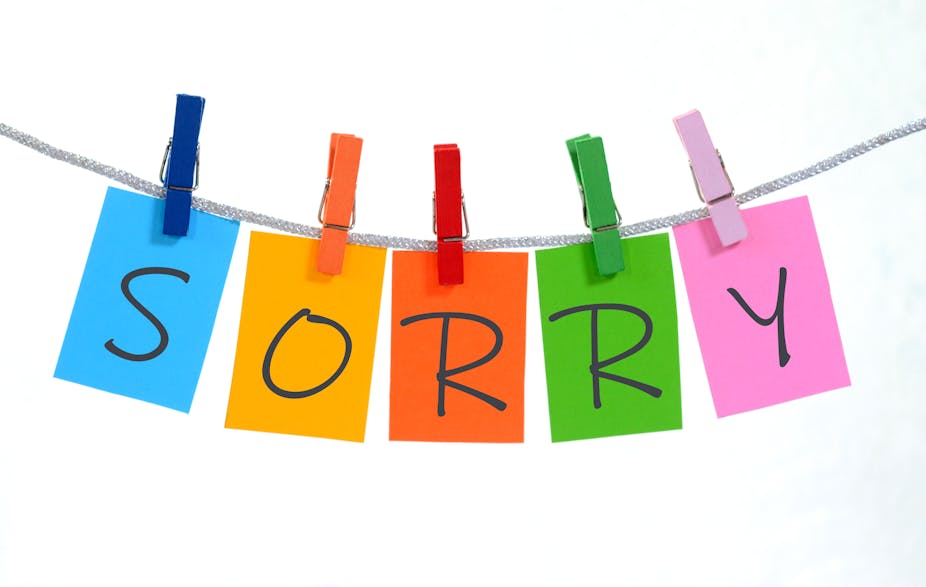
People sometimes flub even when they’re trying to make things right. jayk7/Moment via Getty Images
Nancy E. Berg, Professor of comparative literature, Arts & Sciences at Washington University in St. Louis
Title of course:
Sorry: The art and literature of the apology
What prompted the idea for the course?
A number of years ago our students and faculty read Eula Biss’ book “Notes from No Man’s Land” for our first-year reading program.
It ends with her essay “All Apologies,” which braids together seemingly disparate moments of apology: Biss to her little sister for hitting her, Ronald Reagan’s apology to Japanese Americans for WWII internment, and Bill Clinton’s apologies for marital indiscretion, to Hawaiians for the U.S. overthrowing their monarchy and for the Tuskegee syphilis experiment.
I had the opportunity to expand on a discussion of Biss’ book with a class of first-year students. It started me thinking about the significance of the apology in our lives. From politicians and other public figures to friends and family, we often experience the apology given or withheld.
What does the course explore?
The course explores much more than just the anatomy of an apology and what makes an apology succeed or fail. The course also gets students to consider how apologies can be used to understand historical events, interpersonal relationships and differences in culture and gender. We also discover how apologies provide insight into the nature of celebrity and corporate success.
When former Canadian Prime Minister Stephen Harper apologized in 2015 on behalf of the government for having forcibly removed Indigenous children from their homes to teach them in residential schools, he repeated “we are sorry” in French, Cree, Anishinaabe and Inuktitut, recognizing the very cultures the forcible removal was meant to erase.
After several people died from cyanide-laced Tylenol in 1982, the parent company – Johnson & Johnson – issued a statement that has since become one of most oft-cited examples of an effective corporate apology.
When Ellen DeGeneres apologized in 2020 for fostering a toxic workplace, it missed the mark because she tempered it with humor and didn’t take ownership. Similarly, YouTuber Colleen Ballinger, accused of exploiting her fans, failed spectacularly in her apology, not because it was accompanied by her ukulele strumming but because she painted herself as a victim.
Assignments include a case study that each student chooses and a short research paper on a related topic, such as shame, confession, guilt, forgiveness and absolution.
Why is this course relevant now?
We are living in a post-shame era in which outrageous and offensive behavior is often accepted and even applauded.
For instance, the current governor of Montana body-slammed a reporter while running – successfully – for Congress; entertainer James Corden apologized for berating a hapless waiter but then withdrew the apology; “Real Housewives” throw drinks and flip tables.
The apology itself is often monetized, weaponized or – most often – skipped over. Almost 20 years ago, Aaron Lazare wrote about the growing importance of apology and its power and complexity in his book “On Apology.”
What’s a critical lesson from the course?
A good apology – that is, an effective one – offers a reset, restoring balance or repairing a rupture. A really good apology might even strengthen the relationship between the offender and the offended.
What materials does the course feature?
Course texts include scientific studies, transcripts of apologies, essays and poetry. The novel “Sorry” by Australian writer Gail Jones opens a unit on the national apology, the debt to Indigenous people and the case for reparations.
The unit ends with a screening of Mimi Chakarova’s 2023 film on Russell City – “The Apology”.
Students begin the semester by writing their own personal apologies. I never ask to whom. They are submitted in sealed envelopes. Students revisit their apologies at the end of the semester. I never read them.
What will the course prepare students to do?
My hope is that by the end of the semester the students will be able to apologize effectively. But like all courses in the humanities, it is meant to teach students to analyze and interpret texts and to appreciate the very best creative expressions of humanity, even when created in response to the very worst actions.
This article is republished from The Conversation under a Creative Commons license. Read the original article.






